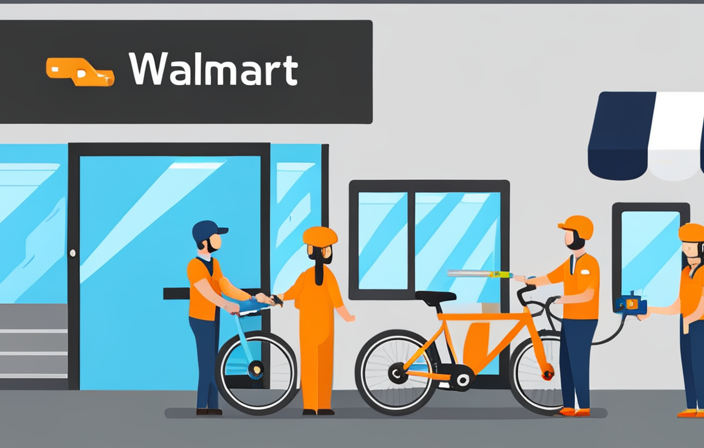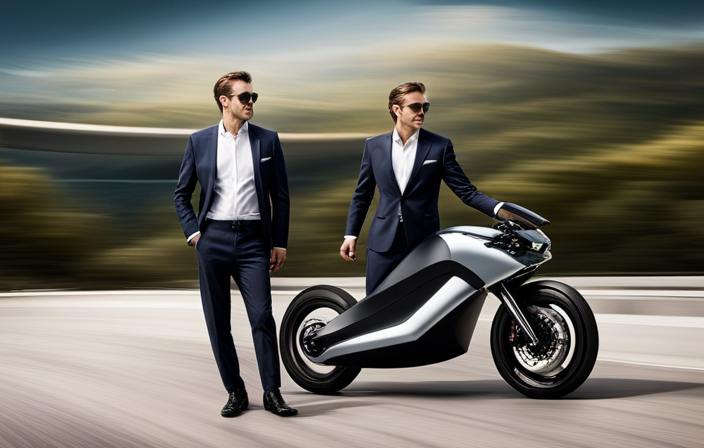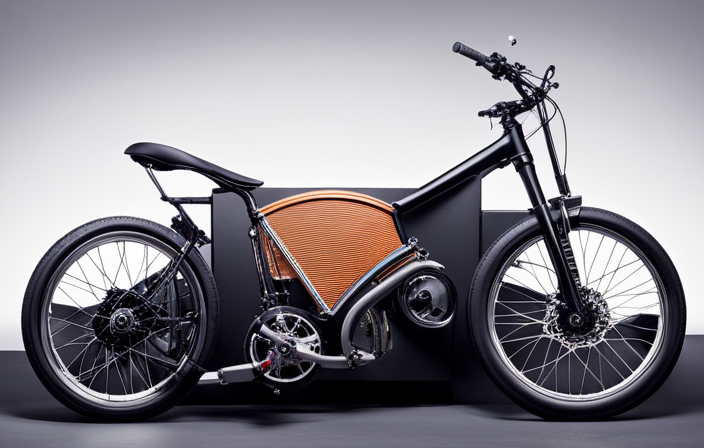I’ve always been fascinated by the idea of harnessing my own energy to power everyday appliances.
So, I set out on a mission to build an electric power generator using just my trusty bike.
In this article, I’ll guide you through the step-by-step process of gathering materials, preparing your bike, installing the generator bracket, and connecting it all together.
Get ready to pedal your way to sustainable energy and enjoy the benefits of your very own electric power generator.
Let’s dive in!
Key Takeaways
- Choose the right generator type based on efficiency and power capabilities
- Calculate power requirements and determine the size and capacity of the generator needed
- Ensure compatibility with the bike frame and install the generator securely
- Connect the generator to the bike’s battery, utilizing it as an energy storage option.
Gather the Necessary Materials
To build an electric power generator with a bike, you’ll need to gather the necessary materials. First, you’ll need to choose the right generator type. There are various options available, such as a permanent magnet generator or an alternator. Consider the power output you require and the type of bike you have, as different generators may have different efficiencies and power capabilities.
Once you’ve chosen the generator type, the next step is to calculate your power requirements. This involves determining how much electricity you need to generate to meet your needs. Consider the devices you plan to power and their power ratings, which are typically measured in watts. Add up the power requirements of all the devices to get a total power requirement. This will help you determine the size and capacity of the generator you’ll need to build.
With the necessary materials gathered and your power requirements calculated, you can now move on to preparing your bike for the generator installation. By modifying the bike’s frame and attaching the generator, you’ll be able to convert mechanical energy from pedaling into electrical energy. This will allow you to generate power while riding your bike.
Transitioning into the next section, let’s now explore how to prepare your bike for the generator installation.
Prepare Your Bike
Make sure your bicycle is in good working condition before starting. It is essential to ensure that all the components of your bike are functioning properly to guarantee a smooth and efficient power generation process. Here are some important steps to prepare your bike for the modification:
-
Check the tires: Inspect the tires for any signs of wear and tear. Replace them if necessary to ensure proper traction and stability during the power generation process.
-
Test the brakes: Ensure that the brakes are working effectively. This is crucial for your safety and to control the speed of the bike while generating power.
-
Lubricate the chain: Apply lubricant to the chain to reduce friction and ensure smooth movement. A well-lubricated chain will help optimize power generation.
-
Adjust the gears: Make sure the gears are properly adjusted to allow for efficient pedaling. Proper gear alignment will maximize power output.
Install the Generator Bracket
Once you have prepared your bicycle, you can easily install the generator bracket. The generator bracket is a crucial component that securely holds the generator in place while allowing it to rotate freely. When choosing a generator bracket, there are a few tips to keep in mind.
Firstly, ensure that it is compatible with the size and type of your bicycle frame. Look for brackets that have adjustable clamps or mounting options to accommodate different frame sizes. Additionally, opt for brackets made from durable materials like steel or aluminum to ensure longevity and stability.
Now, let’s discuss common mistakes to avoid when installing the generator bracket. One mistake is not tightening the bracket securely enough. This can lead to vibrations and wobbling, which can affect the efficiency and performance of the generator. Make sure to use the appropriate tools and follow the manufacturer’s instructions for tightening the bracket. Another mistake is not aligning the bracket properly with the bike frame. This can cause the generator to rub against the tire or other components, leading to unnecessary friction and potential damage.
With the generator bracket securely in place, it’s time to connect the generator to the bike.
Connect the Generator to the Bike
Now that you have the generator bracket securely installed, it’s time to connect it to your bicycle. Follow these steps to ensure a successful connection:
-
Locate the generator’s wiring harness and identify the wires labeled for power output. These wires will typically be color-coded, with red indicating positive and black indicating negative.
-
Connect the positive wire to the positive terminal of the bike’s battery. This will allow the generated power to flow into the battery for storage. Ensure a secure connection using crimp connectors or soldering, and protect the connection with heat shrink tubing.
-
Connect the negative wire to the negative terminal of the battery. This completes the circuit and allows the current to flow from the generator to the battery.
By connecting the generator to your bike’s battery, you can effectively harness the power generated by pedaling. This setup not only increases the power generation efficiency but also provides energy storage options. With the battery acting as a reservoir, you can store excess power generated during high-output periods and utilize it later when needed.
Now that you have successfully connected the generator to your bike, it’s time to attach the battery and start reaping the benefits of your electric power generator.
Attach the Battery
To attach the battery, you’ll want to locate the appropriate terminals for connection. Before installing the battery, it is important to follow safety measures to ensure a secure attachment. Here are the steps to safely install the battery:
| Terminal | Description |
|---|---|
| Positive (+) | This terminal is usually marked with a "+" symbol and is connected to the positive side of the battery. |
| Negative (-) | This terminal is usually marked with a "-" symbol and is connected to the negative side of the battery. |
- Begin by identifying the positive and negative terminals on the battery.
- Make sure the generator is turned off and disconnected from any power source.
- Connect the positive terminal of the battery to the positive wire of the generator using a suitable connector or terminal clamp.
- Connect the negative terminal of the battery to the negative wire of the generator using a suitable connector or terminal clamp.
- Ensure that the connections are tight and secure to avoid any loose connections or accidental disconnections.
Connect the Battery to the Generator
Start by ensuring that the positive and negative terminals on the battery are correctly identified. This is crucial for connecting the battery to the generator. Once you have identified the terminals, you need to choose the appropriate charging option for your battery.
There are different options available, such as using a solar panel or a conventional charger. Consider the battery capacity when making this decision. If you have a high-capacity battery, you may need a more powerful charging option to ensure efficient charging.
To connect the battery to the generator, you will need to use appropriate cables or wires. Make sure to use cables that are compatible with the battery and generator connections. Connect the positive terminal of the battery to the positive terminal of the generator and the negative terminal of the battery to the negative terminal of the generator. This will establish the electrical connection between the two components.
Now that the battery is connected to the generator, it’s time to test the generator and see if it is working properly. This step will ensure that the generator is generating electricity and charging the battery effectively. By testing the generator, you can identify any issues or malfunctions that need to be addressed before using it for powering devices or appliances.
Test the Generator
After connecting the battery to the generator, it’s important to test its functionality to ensure it’s working properly. Monitoring the power output is crucial during this step.
To begin, turn on the generator and observe the power meter. It should display the current power output in watts. If the meter shows a reading, it indicates that the generator is producing electricity. However, if there is no reading or the reading is too low, it signifies a problem.
Troubleshooting common issues can help resolve this. First, check the battery connection to ensure it is secure and properly connected. Next, inspect the wiring for any loose or damaged connections. Additionally, examine the generator’s components for any signs of wear or malfunction. If the issue persists, consult the user manual or seek assistance from a professional.
Once you have tested the generator’s functionality and addressed any problems, you can move on to determining the power output in the next section.
Determine the Power Output
Check the wattage meter to determine the power output of your generator. This is an important step in calculating the efficiency of your generator and measuring power consumption. Here are three key things to consider:
-
Voltage: The wattage meter will display the voltage output of your generator. This is crucial in determining the power output, as power is calculated by multiplying the voltage by the current. Make sure the voltage is within the desired range for your specific application.
-
Current: The wattage meter will also provide information about the current flowing through your generator. This, along with the voltage, is essential in calculating the power output. It is important to measure the current accurately to get an accurate power reading.
-
Power Factor: The wattage meter may also display the power factor, which indicates how efficiently the generator converts input power into output power. A power factor of 1 indicates maximum efficiency, while a lower power factor indicates power losses.
By checking the wattage meter and considering these factors, you can determine the power output of your generator. This information is crucial for understanding the performance of your generator and ensuring it meets your power requirements.
Once you have determined the power output, you can move on to the next step of using a voltage regulator to maintain a stable voltage output.
Use a Voltage Regulator
To ensure a stable voltage output, you’ll need a voltage regulator for your generator. A voltage regulator is a device that controls the voltage level and ensures a consistent output for your electrical devices. It plays a crucial role in improving power output and protecting your devices from voltage fluctuations.
Using a voltage regulator can greatly enhance the performance of your generator by regulating the voltage and preventing overvoltage or undervoltage situations. It acts as a buffer between the generator and your devices, ensuring that they receive a constant and reliable power supply.
Troubleshooting common issues with voltage regulators is essential to maintain their functionality. Some common issues include overheating, voltage spikes, and failure to regulate voltage properly. To address these problems, it is important to regularly inspect and clean the voltage regulator, ensure proper ventilation, and check for any loose connections. Additionally, monitoring the voltage output and conducting regular tests can help identify any potential issues.
Connect Your Devices
Make sure you properly connect your devices to the voltage regulator to ensure a stable and reliable power supply. Here are some important things to consider when connecting your devices:
-
Use appropriate cables and connectors: Select cables and connectors that match the charging options and power requirements of your devices. This will ensure efficient power transfer and prevent any damage to your devices.
-
Check the power consumption: Before connecting your devices, it’s crucial to know their power consumption. This information can help you determine if your generator and voltage regulator can handle the load. Exceeding the capacity can lead to overheating or even failure of the system.
-
Connect in parallel or series: Depending on the nature of your devices, you can connect them in parallel or series. Parallel connection allows each device to receive the same voltage and share the current, while series connection divides the voltage among the devices. Consider the compatibility and power distribution requirements of your devices when making this decision.
-
Proper grounding: Ensure proper grounding of your generator and voltage regulator to prevent electrical shocks and ensure the safety of your devices.
By following these guidelines, you can effectively connect your devices to the voltage regulator and optimize the power supply.
Now, let’s move on to the next section and learn how to monitor the power generated without interrupting the system.
Monitor the Power Generated
Ensure you have a reliable method for monitoring the amount of power being generated. Monitoring power usage is crucial to understanding the efficiency of your electric power generator and maximizing power output. By keeping track of the power being generated, you can make adjustments to optimize performance and prevent any potential issues.
To effectively monitor the power generated, you can use a watt meter or power monitor. These devices provide real-time information about the amount of power being produced by your generator. By connecting the watt meter or power monitor between your generator and the load, you can easily measure the power output.
Here is a simple example of a table showcasing the power usage and output:
| Load (Watts) | Generator Output (Watts) | Efficiency (%) |
|---|---|---|
| 100 | 120 | 83.33 |
| 200 | 240 | 83.33 |
| 300 | 360 | 83.33 |
| 400 | 480 | 83.33 |
| 500 | 600 | 83.33 |
By regularly monitoring the power output and efficiency, you can identify any fluctuations or inefficiencies in your generator. This will allow you to make adjustments and fine-tune your setup to maximize power output.
Now that you have a reliable method for monitoring the power generated, let’s move on to the next section on how to maintain your electric power generator.
Maintain Your Electric Power Generator
Regular maintenance is essential for keeping your electric power generator in optimal condition. By performing routine maintenance, you can ensure that your generator operates efficiently and effectively.
One important aspect of maintenance is troubleshooting common issues that may arise. This includes checking for loose connections, inspecting the fuel and oil levels, and cleaning or replacing the air filter. By addressing these issues promptly, you can prevent further damage and maximize the lifespan of your generator.
Another crucial aspect of maintenance is maximizing energy efficiency. This can be achieved by regularly inspecting and adjusting the carburetor, as well as cleaning the fuel system. Additionally, maintaining proper oil levels and changing the oil regularly will help to minimize friction and ensure smooth operation.
Proper maintenance also involves regularly testing the generator to ensure it is functioning correctly and producing the desired amount of power. By following these maintenance procedures, you can keep your electric power generator running smoothly and efficiently.
Now, let’s explore how you can expand your system to meet your power needs even further.
Expand Your System
Expanding your system can provide you with the additional power capacity you need to meet your growing demands. When it comes to expanding power capacity, there are a few key considerations to keep in mind.
-
Upgrading your generator: By investing in a larger generator, you can increase the overall power capacity of your system. This will allow you to handle higher loads and meet the demands of your expanding needs.
-
Adding more solar panels: Incorporating additional solar panels into your system can help maximize energy efficiency. By capturing more sunlight and converting it into electricity, you can generate more power to meet your increased demands.
-
Installing a battery storage system: A battery storage system allows you to store excess electricity generated by your system for later use. This ensures that you have a reliable power supply even during periods of low sunlight or high demand.
Expanding your system not only boosts your power capacity but also enhances the overall efficiency of your setup. However, before proceeding with any expansion, it is crucial to consider safety precautions to ensure the protection of both yourself and your equipment.
Consider Safety Precautions
Before proceeding with any expansion, it’s important to take safety precautions into account to protect yourself and your equipment. When working with electricity, there are certain risks involved that must be mitigated. To ensure proper ventilation, make sure your workspace is well-ventilated, as generators produce exhaust fumes that can be harmful if inhaled. Additionally, it is crucial to use appropriate safety gear such as gloves, goggles, and a face mask to protect yourself from any potential electrical hazards or debris.
To further emphasize the importance of safety, let’s take a look at the following table:
| Safety Precautions | Description | Importance |
|---|---|---|
| Proper Ventilation | Ensures removal of harmful fumes | Prevents health risks |
| Safety Gear | Protects against electrical hazards and debris | Minimizes potential injuries |
Enjoy the Benefits of Your Electric Power Generator
Now that we have covered the safety precautions necessary for building an electric power generator with a bike, let’s move on to the exciting part: enjoying the benefits of your creation.
By following the steps outlined in the previous subtopics, you have successfully converted mechanical energy from pedaling into electrical energy. Now, it’s time to maximize the efficiency of your generator and troubleshoot any common issues that may arise.
To maximize the efficiency of your electric power generator, there are a few things to consider. First, ensure that your bike is properly maintained and in good working condition. A well-oiled chain and properly inflated tires will reduce friction and increase the efficiency of power transfer. Additionally, make sure the generator is positioned close to the rear wheel to minimize power loss through the transmission system.
Troubleshooting common issues is an important skill to have when using an electric power generator. One common issue is a drop in power output. This can be caused by loose connections or worn-out components. Check all the connections and replace any damaged or worn-out parts. Another issue could be excessive noise or vibrations. In this case, check for loose bolts and tighten them as necessary.
Frequently Asked Questions
How much power can an electric power generator built with a bike produce?
An electric power generator built with a bike can produce a significant amount of power, depending on various factors. The efficiency of the generator is determined by the quality of the components used and the design of the system.
It is essential to consider factors like resistance, gear ratios, and the cyclist’s power output. These factors can greatly affect the overall performance and output of the generator.
The potential applications of such a generator are diverse. It can be used to power small electronic devices, such as smartphones or laptops, making it a convenient and eco-friendly option for charging on the go. Additionally, it can be used to charge batteries, providing a sustainable energy source for portable power needs.
In certain scenarios, a bike generator can even contribute to the grid. By connecting the generator to an inverter, the generated power can be fed back into the electrical grid, offsetting energy consumption and reducing reliance on traditional power sources.
Overall, building a bike generator offers a range of possibilities for generating power in a sustainable and efficient way. It not only provides a practical solution for personal power needs but also contributes to a greener and more sustainable energy future.
What are some common safety precautions to consider when building an electric power generator with a bike?
When building an electric power generator with a bike, it is crucial to prioritize safety precautions.
One important aspect is grounding, which ensures the safe dissipation of excess electrical energy. Without proper grounding, there is a risk of electric shocks and damage to the system.
Additionally, overloading the system can lead to overheating and potential fire hazards. It is essential to carefully calculate and monitor the power load to prevent these risks and ensure a safe operation.
Can I connect multiple batteries to the generator for increased power storage?
Using multiple batteries for increased power storage in an electric power generator has both pros and cons.
On the positive side, it allows for storing more energy, providing longer power supply during outages. However, it also increases the weight and cost of the system.
To properly connect and manage multiple batteries, it is crucial to use a battery management system to ensure balanced charging and discharging. Additionally, proper wiring and sizing of the cables are essential to minimize power losses.
How long does it take to gather all the necessary materials for building an electric power generator with a bike?
Gathering all the necessary materials for building an electric power generator with a bike can be quite a task. One alternative method to find these materials is by checking online marketplaces like eBay or Amazon.
Additionally, local hardware stores or recycling centers may have some of the required components. Remember to look for items such as a bicycle, a DC motor, a battery, and an inverter.
With some patience and resourcefulness, you can find everything you need to start building your generator.
Can I use any type of bike for this project or are there specific requirements?
For this project, it’s important to select a bike that meets certain requirements.
While any bike can technically be used, there are advantages to using a specific type of bike. A mountain bike, for example, is ideal due to its sturdy construction and ability to handle rough terrains.
Additionally, a bike with multiple gears allows for greater control and efficiency when generating power.
Considering these alternative bike options will ensure the success of your electric power generator project.
Conclusion
In conclusion, building an electric power generator with a bike is a rewarding and practical project. By following the steps outlined in this article, you can harness the power of your own physical effort to generate electricity.
This ingenious system not only provides a sustainable energy solution, but also promotes a healthier lifestyle. So, hop on your bike, pedal your way to a greener future, and witness the transformation of your energy output.
The journey to self-sufficiency begins with a few simple steps and a world of possibilities awaits.








